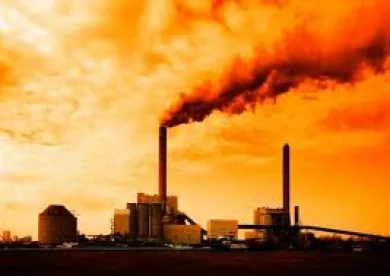On September 30, 2015, the United States Environmental Protection Agency (EPA) issued the pre-publication notice of a final rule that sets new technology-based effluent limitations guidelines and standards (ELGs) for the steam electric power generating industry. Both the final rule and the proposed rule published in June 2013 were issued pursuant to a schedule approved by a federal court.[1] EPA is preparing the final rule for publication in the Federal Register; it will become effective 60 days after its date of publication. Implementation of its new requirements, however, will generally be through NPDES permits issued or renewed after November 2018.
Background
EPA promulgated the final rule under the Clean Water Act (CWA) to revise the 1982 steam electric ELGs and reflect what the agency believes to be updated technology-based pollution controls. The CWA authorizes the discharge of pollutants from point sources to waters of the United States through its NPDES permit program. To establish technology-based floors of performance for all NPDES permit dischargers, the CWA contemplates EPA’s periodic issuance of national ELGs for various industry sectors, including the steam electric industry.
Overview of the Final Rule for Existing Facilities
Generally, the new ELGs apply to steam electric power plants that use nuclear or fossil fuels to heat water in boilers except those with a nameplate capacity of 50 MW or less. The final rule specifically regulates six types of wastestreams: FGD wastewater, fly ash transport water, bottom ash transport water, flue gas mercury control (FGMC) wastewater, gasification wastewater, and combustion residual leachate.
EPA decided not to set national ELGs for non-chemical metal cleaning wastes because the agency did not have sufficient information on a national basis to set technology-based requirements. EPA did not know the extent to which discharges of non-chemical metal cleaning wastes occur or the management practices industry employs to deal with these wastes. Instead, the agency reserved limitations and standards for this waste, allowing the permitting authority to establish such requirements at individual plants based on best professional judgment. In doing so, EPA contemplates that the permitting authority will examine the historical permitting record for a particular plant.[2]
The below table provides an overview of the final rule’s requirements for each of the six regulated wastestreams:
|
Wastestreams |
Applicable Effluent Limitations[3] |
Technology Anticipated to Be Used to Meet the Effluent Limitations[4] |
Implementation and Timing |
|
|
|
|
|
|
|
|
|
|
|
|
|
Legacy Wastewater[6] |
|
|
|
|
|
|
|
For oil-fired generating units and small generating units (i.e., those with nameplate capacity of 50 MW or less), the final rule sets Best Available Technology (BAT) limitations on TSS based on existing BPT regulations. These limitations apply to the discharge of bottom ash transport water, FGMC wastewater, fly ash transport water, FGD wastewater, and gasification wastewater. Following the effective date of the final rule, these BAT limits will apply on the date the permit is issued.
Conclusion
The pre-publication notice of the final rule is accessible here. The new ELGs will place a significant burden on affected segments of the steam electric power generating industry. This burden will be especially pronounced for pollutants found in three wastestreams: fly ash transport water, bottom ash transport water, and FGMC wastewater.
[1] See EPA, Effluent Limitations Guidelines and Standards for the Steam Electric Power Generating Point Source Category, 78 Fed. Reg. 34,432 (proposed June 7, 2013), available at http://www.gpo.gov/fdsys/pkg/FR-2013-06-07/pdf/2013-10191.pdf.
[2] According to EPA’s recommended approach, if the non-chemical metal cleaning waste discharges had been treated as low volume waste sources, then they would continue to be treated as low volume waste sources. The final rule has changed the definition of “low volume waste sources,” by, in part, clarifying that FGD wastewater, FGMC wastewater, gasification wastewater, and combustion residual leachate are no longer considered low volume waste sources. Also, wastewater from carbon capture or sequestration systems is specifically excluded from the low volume waste sources definition.
[3] The actual numerical limit on the quantity of pollutants discharged is calculated by multiplying the flow of the applicable wastewater times the concentrations listed in the table. See EPA, Effluent Limitations Guidelines and Standards for the Steam Electric Power Generating Point Source Category, at 282 (Sept. 30, 2015).
[4] The final rule is similar to Option 4 of the proposed rule published in 2013, an option which that proposed rule did not identify as one of EPA’s four “preferred options.” The difference between the Option 4 of the proposed rule and the final rule appears to be the effluent limitations for combustion residual leachate. In the proposed rule, Option 4 based the limitations on chemical precipitation, but the final rule expresses the technology requirement as surface impoundments (effectively equal to the previously promulgated BPT limitations on TSS for low volume waste sources). See id. at 57, tbl. VIII-1.
[5] Id. at 217.
[6] “Legacy wastewater” is defined as “FGD wastewater, fly ash transport water, bottom ash transport water, FGMC wastewater, or gasification wastewater generated prior to the date determined by the permitting authority that is as soon as possible beginning November 1, 2018, but no later than December 31, 2023.” Id. at 88.



 />i
/>i
